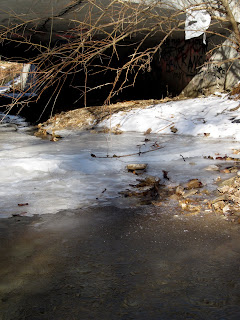
Hey everyone!
So today I got to do something that I don’t usually get to do: go out in the field!
Not too terribly early this morning (thankfully), Darlene Haun of the Missouri Department of Conservation took Theo, Stacy, Lorin and I out to do water quality monitoring on Fishpot Creek in St. Louis County.
Like many urban and semi-urban streams, Fishpot has a host of problems. The key issue is volume: excessive development along the stream banks has increased runoff to more than the stream can handle. Fishpot is notoriously bad during rain, and can become extremely dangerous because water levels rise nearly 20 feet in a very short time. The flash flooding contributes to and exacerbates the acute erosion along the creek; in fact, the erosion was so bad along a street called Pepperdine Court that the St. Louis Metropolitan Sewer District had to do an expensive stream bank restoration just to prevent six houses from falling 20 feet into the stream.
We were testing for chlorides because the snow that fell last week has started to melt—and aaaallll the salt that was put down is washing off into the creeks. We tested five sites along the stream, and found conductivity well above toxic levels for fish at four.
After we finished gathering data and taking water sample from every site, we headed to Valley Park Middle School to work with a 6th grade class. This class will actually be their own Stream Team in the spring, and they were very excited about getting to go out and work on the creek.
Darlene set up the chloride testing strips in our water samples for all the kids to see, 
When the chloride testing strips were ready, the kids helped us read them. As predicted, chloride levels were reading much higher than normal. For a comparison, and to show the correlation between elevated conductivity levels and salt in the water, we also tested conductivity in tap water, distilled water, and sparkling water.
It was a nice change of pace to be out-of-doors and working in the stream, especially after the frigid weather we’d been having. (By the way, that's me testing conductivity, you can tell by the hair.) I also really enjoyed being in a classroom and interacting with the kids; I’m so glad that MDC is getting younger children involved in and excited about their local watershed. It’s always good to start those future AmeriCorps members young!
I look forward to seeing you all at the conference in a few weeks!


1 comment:
Thanks for sharing this useful info.. water damage restoration tampa
Post a Comment